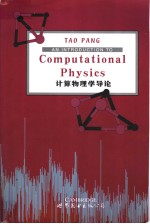

计算物理学导论 英文版PDF电子书下载
- 电子书积分:13 积分如何计算积分?
- 作 者:(英)Tao Pang著
- 出 版 社:世界图书出版公司北京公司
- 出版年份:2001
- ISBN:7506249618
- 页数:374 页
1 Introduction 1
1.1 Computation and science 1
1.2 The emergence of modern computers 2
1.3 Computer algorithms and languages 4
2 Basic numerical methods 11
2.1 Interpolations and approximations 11
2.2 Differentiation and integration 25
2.3 Zeros and extremes of a single-variable function 31
2.4 Classical scattering 39
2.5 Random number generators 45
3 Ordinary differential equations 55
3.1 Initial-value problems 56
3.2 The Euler and Picard methods 56
3.3 Predictor-corrector methods 58
3.4 The Runge-Kutta method 60
3.5 Chaotic dynamics of a driven pendulum 63
3.6 Boundary-value and eigenvalue problems 67
3.7 The shooting method 69
3.8 Linear equations and the Sturm-Liouville problem 74
3.9 The one-dimensional Schrodinger equation 79
4 Numerical methods for matrices 88
4.1 Matrices in physics 88
4.2 Basic matrix operations 91
4.3 Linear equation systems 93
4.4 Zeros and extremes of a multivariable function 103
4.5 Eigenvalue problems 107
4.6 The Faddeev-Leverrier method 116
4.7 Electronic structure of atoms 117
4.8 The Lanczos algorithm and the many-body problem 120
4.9 Random matrices 122
5 Spectral analysis and Gaussian quadrature 127
5.1 The Fourier transform and orthogonal functions 128
5.2 The discrete Fourier transform 129
5.3 The fast Fourier transform 132
5.4 The power spectrum of a driven pendulum 137
5.5 The Fourier transform in higher dimensions 139
5.6 Wavelet analysis 140
5.7 Special functions 148
5.8 Gaussian quadrature 153
6 Partial differential equations 158
6.1 Partial differential equations in physics 158
6.2 Separation of variables 159
6.3 Discretization of the equation 163
6.4 The matrix method for difference equations 165
6.5 The relaxation method 170
6.6 Groundwater dynamics 173
6.7 Initial-value problems 178
6.8 Temperature field of nuclear waste storage facilities 181
7 Molecular dynamics simulations 186
7.1 General behavior of a classical system 186
7.2 Basic methods for many-body systems 188
7.3 The Verlet algorithm 192
7.4 Structure of atomic clusters 197
7.5 The Gear predictor-corrector method 200
7.6 Constant pressure, temperature, and bond length 202
7.7 Structure and dynamics of real materials 208
7.8 Ab initio molecular dynamics 212
8 Modeling continuous systems 219
8.1 Hydrodynamic equations 219
8.2 The basic finite element method 221
8.3 The Ritz variational method 226
8.4 Higher-dimensional systems 230
8.5 The finite element method for nonlinear equations 234
8.6 The particle-in-cell method 236
8.7 Hydrodynamics and magnetohydrodynamics 241
8.8 The Boltzmann lattice-gas method 244
9 Monte Carlo simulations 250
9.1 Sampling and integration 250
9.2 The Metropolis algorithm 253
9.3 Applications in statistical physics 260
9.4 Critical slowing down and block algorithms 265
9.5 Variational quantum Monte Carlo simulations 267
9.6 Green’s function Monte Carlo simulations 272
9.7 Path-integral Monte Carlo simulations 276
9.8 Quantum lattice models 278
10 Numerical renormalization 286
10.1 The scaling concept 286
10.2 Renormalization transform 289
10.3 Critical phenomena: The Ising model 291
10.4 Renormalization with Monte Carlo simulation 295
10.5 Crossover: The Kondo problem 296
10.6 Quantum lattice renormalization 300
10.7 Density matrix renormalization 304
11 Symbolic computing 309
11.1 Symbolic computing systems 309
11.2 Basic symbolic mathematics 311
11.3 Computer calculus 313
11.4 Linear systems 315
11.5 Nonlinear systems 318
11.6 Differential equations 320
11.7 Computer graphics 324
11.8 Dynamics of a flying sphere 326
12 High-performance computing 332
12.1 The basic concept 332
12.2 High-performance computing systems 334
12.3 Parallelism and parallel computing 337
12.4 Data parallel programming 341
12.5 Distributed computing and message passing 349
12.6 Some current applications 354
References 357
Index 367
- 《卓有成效的管理者 中英文双语版》(美)彼得·德鲁克许是祥译;那国毅审校 2019
- 《新编高中物理竞赛教程习题全解》钟小平主编;钟小平,倪国富,曹海奇编写 2019
- 《物联网导论》张翼英主编 2020
- 《数学物理方法与仿真 第3版》杨华军 2020
- 《材料导论》张会主编 2019
- 《化工传递过程导论 第2版》阎建民,刘辉 2020
- 《中学物理奥赛辅导:热学 光学 近代物理学》崔宏滨 2012
- 《长江口物理、化学与生态环境调查图集》于非 2019
- 《大学物理简明教程 下 第2版》施卫主编 2020
- 《慢性呼吸系统疾病物理治疗工作手册》(荷)瑞克·考斯林克(RikGosselink) 2020
- 《中风偏瘫 脑萎缩 痴呆 最新治疗原则与方法》孙作东著 2004
- 《水面舰艇编队作战运筹分析》谭安胜著 2009
- 《王蒙文集 新版 35 评点《红楼梦》 上》王蒙著 2020
- 《TED说话的力量 世界优秀演讲者的口才秘诀》(坦桑)阿卡什·P.卡里亚著 2019
- 《燕堂夜话》蒋忠和著 2019
- 《经久》静水边著 2019
- 《魔法销售台词》(美)埃尔默·惠勒著 2019
- 《微表情密码》(波)卡西亚·韦佐夫斯基,(波)帕特里克·韦佐夫斯基著 2019
- 《看书琐记与作文秘诀》鲁迅著 2019
- 《酒国》莫言著 2019
- 《TED说话的力量 世界优秀演讲者的口才秘诀》(坦桑)阿卡什·P.卡里亚著 2019
- 《小手画出大世界 恐龙世界》登亚编绘 2008
- 《近代世界史文献丛编 19》王强主编 2017
- 《课堂上听不到的历史传奇 世界政治军事名人 初中版》顾跃忠等编著 2015
- 《指向核心素养 北京十一学校名师教学设计 英语 七年级 上 配人教版》周志英总主编 2019
- 《365奇趣英语乐园 世界民间故事》爱思得图书国际企业 2018
- 《近代世界史文献丛编 36》王强主编 2017
- 《北京生态环境保护》《北京环境保护丛书》编委会编著 2018
- 《近代世界史文献丛编 11》王强主编 2017
- 《近代世界史文献丛编 18》王强主编 2017
